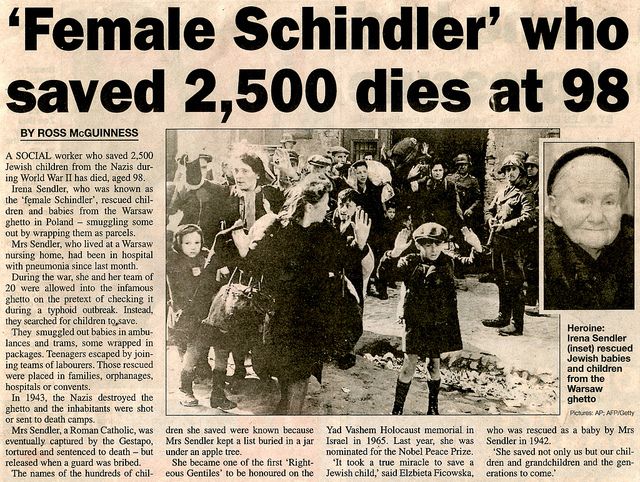Winner of the Spring 2018 StMU History Media Award for
Best Article in the Category of “Political History”
Best Article in the Category of “World History”
At the age of twenty-nine, Irena Sendler was a social worker with the Polish welfare department when Hitler invaded Poland in September 1939, launching World War II. But before that, Sendler had a unique childhood, growing up in the Polish town of Otwock. In her small town, Irena played with the other children. It never mattered to her or her family that the other children were Jewish, and they were Roman Catholic. During college, she studied Polish literature and became active in the Polish Socialist party.1

In October 1940, around 450,000 Jews were held in a 16-block neighborhood in Warsaw, marking the opening of the Warsaw Ghetto. The conditions that the people lived in were horrendous: packed houses, limited or no food and water, diseases running rampant.2 Hundreds of Jews were dying each week from sickness, starvation, and bullets. That same year, Irena Sendler joined the Polish Underground. Working as a social worker and working with the Polish Underground, Sendler had unique access to the ghettos given to her by city officials. Her official reason for being there was to help fight contagious diseases, because the Germans there did not want to risk getting sick themselves. Her unofficial reason for being there was to provide clothing, medicine, money, and false documents.3
Inside the Warsaw Ghetto, Sendler would often wear the Star of David on her arm, to show that she was united with the Jewish people and so that she would not draw attention to herself.4 Eventually, she began to smuggle people out of the ghetto and move them to places of safety. Between the years 1939 and 1942, Irena and her helpers made over five hundred false documents to help Jewish families escape from the ghettos.5

Sendler’s work in the Polish Underground brought her to the Council for Aid to Jews, known by the code name “Zegota.”6 This organization was dedicated to helping Jewish families and was funded in part by the Polish Government in exile in London. It was a dangerous time for people to be helping Jews. Those who were found hiding Jews were executed, along with their entire family.
By 1942, extermination camps, like Auschwitz and Treblinka, had been constructed to hold and exterminate Jews. Sendler knew that if she wanted to help more, she needed to act quickly. She was sent to the ghetto to monitor typhus. In 1917, when Sendler was just seven, her father Dr. Stanislaw Krzyzanowski had died from treating sick Jews. Her father had been the only doctor in their hometown who would treat sick Jews.7 Dr. Krzyzanowski remained a lifelong influence in her life and was the main reason behind her actions during the war.
In December of 1942, Irena Sendler was made head of Zegota’s children division, because of her previous experience smuggling false papers in and providing exits for Jews in the ghetto. The children that she rescued only knew her by her code name “Jolanta,” which Zegota gave her to deter any of the Germans from discovering their group.8
Sendler and her team of about two dozen or so, including Antoni Dzbrowski, a driver who would hide children in his lorry truck, would smuggle children out of the ghettos.9 She would ask mothers to give up their children, not being able to promise that they would survive or even make it through the ghetto gates. She gave them hope that there was a small chance for their children’s survival, a chance greater than staying in the ghetto. One mother gave up her daughter Elzbieta Ficowska, leaving her with only a small silver spoon with her name and birth date written on it.10 Other means of escape were through fake deaths. Children would be given sleeping medicine and were able to pass through because German officials were told the children died of typhus. Other children were brought to the sewer. There were reports of a dog that was taught to bark to cover the cries of babies.11 The most popular escape route, however, was through the Warsaw Municipal Law Courts, which shared an edge with the Warsaw ghetto. The courthouse had secret doors on both sides and underground corridors, and Zegota members bribed the Polish Officials who oversaw the patrolling of the corridors, so the children were able to be smuggled out unseen.12
I was taught that if you see a person drowning, you must jump into the water to save them, whether you can swim or not.13
The children who escaped were provided with false identities. Many of the children were taught Christian prayers and would live with Christian families who agreed to take them in. Some children would go to live in Catholic or non-religious convents and orphanages. Sendler would write the child’s Jewish name, their parents’ name, and the child’s new Polish name down in code to be buried in jam jars under a neighbor’s tree.14
On April 19, 1943, the Nazis began to liquidate the ghettos, which meant that the Jews who were considered able to work would be sent to concentration camps and those who were not would be killed. It took the Nazis more than a month to finish the liquidation, due to the uprising within the Warsaw ghetto. The Polish Underground was fighting outside the ghetto, aiming for German trucks. By then, only about 55,000 Jews remained alive, either from escaping or from being left in the ghettos.15
True to their word, the Nazis were dedicated to capturing and killing all those who were aiding Jewish people. A member of the underground was caught and tortured, and he gave up Sendler’s name and address. On October 20, 1943, the Nazi Gestapo raided Sendler’s apartment and arrested her. Sendler was taken to the notorious Pawiak Prison in Warsaw, a place where many went in, but few left alive.16 At the prison, she was first asked to reveal the names of people she worked with, the names of children she saved, and her current living arrangement, but she remained silent. Then she was tortured, her feet and then legs were broken with the use of clubs. She still did not talk. She was beaten and tortured more, but she never spoke a word. After realizing that she would never tell them anything, the Nazis publicly announced her death. She was sentenced to die by firing squad. Unknown to her, Zegota had been working on her escape. The organization bribed a German guard to release her on the morning of her execution and the guard followed through. The Germans did not want to admit officially that she had escape, so Sendler was listed on public bulletin boards as among those executed.17

Irena Sendler then went into hiding like the children that she had been sent to rescue. However, she managed to continue her work under a different name. When World War II finally ended in 1945, she hoped to reunite many of the 2,500 children taken out of the Ghetto with their parents. Irena Sendler dug up the jars, but by that point the Ghetto was largely empty. Many of the Jewish parents had died during the Holocaust, and few were able to find their children. Most of the ghetto families had died in the ghetto or in the nearby Treblinka death camp.
Between the years 1940 and 1943, Irena “Jolanta” Sendler and her team smuggled about 2,500 children out of the Warsaw ghetto.18 The total estimated lives that Sendler saved was about 3,000.
Irena Sendler’s struggle did not end when the war ended. After the war, Poland became a Soviet ally and fell under Communist rule. Irena was able to start using her real name once again and leave her life of hiding, but she faced harassment because of her work with Zegota, which also held many anti-communist beliefs.19 She married and got pregnant, but due to the harassment and stress, her son was born prematurely and died. Sendler continued her social work by founding and funding orphanages and nursing homes.
The term ‘heroine’ irritates me greatly. The opposite is true. I continue to have pangs of conscience that I did so little.20

The first official recognition of her actions during the war came in 1965, when she was named one of the Righteous Among the Nations. Irena Sendler was one of the first to be awarded this title. However, she was not able to receive the medal until 1983, when she obtained a passport to travel to Israel. In 2000, a group of students from Kansas created a play called Life in a Jar. In 2003 she was honored with the Order of the White Eagle, Poland’s most esteemed award given to civilians and military for their actions.21 In 2007, she was nominated for a Nobel Peace Prize, but lost to Al Gore’s presentation of Global Warming. She died in 2008, at the age of 98. But her story did not end with her death. In 2009, the film The Courageous Heart of Irena Sendler was released.
- Antony Polonsky, “Obituary: Irena Sendler: Polish social worker who saved around 2,500 Jewish children from the Nazis,” The Guardian, May 14, 2008 https://www.theguardian.com/world/2008/may/14/secondworldwar.poland. ↵
- Joachim Wieler, “Remembering Irena Sendler: A Mother Courage honored as most distinguished social worker of IFSW,” International Social Work 51 (November 2008): 835. ↵
- Ronald Smelser, Learning About the Holocaust: A Student’s Guide-Irena Sendler (2001), 6-7. ↵
- Encyclopedia of World Biography, 2008, s.v. “Irena Sendler.” ↵
- Elaine Woo, “Irena Sendler, 98; saved 2,500 children in the Holocaust,” Los Angeles Times, May 13, 2008 http://archive.boston.com/bostonglobe/obituaries/articles/2008/05/13/irena_sendler_98_saved_2500_children_in_the_holocaust/?page=2. ↵
- Pulgarin Bilvao and Lissette Paola,” Irena Sendler: A Nurse Example of Love of Freedom,” Investigacion & Educacion En Enfermeria 30, no. 2 (July 2012). ↵
- “Call Her the Nazis’ Nightmare; Act with Courage: Irena Sendler saved thousands of kids from the Warsaw ghetto,” Investor’s Business Daily February 4, 2004. ↵
- Encyclopedia of World Biography, 2008, s.v. “Irena Sendler.” ↵
- Antony Polonsky, “Obituary: Irena Sendler: Polish social worker who saved around 2,500 Jewish children from the Nazis,” The Guardian, May 14, 2008. https://www.theguardian.com/world/2008/may/14/secondworldwar.poland. ↵
- Maggie Jones, “The Smuggler,” The New York Times December 27, 2008. http://www.nytimes.com/2008/12/28/magazine/28sendler-t.html. ↵
- “Call Her the Nazis’ Nightmare; Act with Courage: Irena Sendler saved thousands of kids from the Warsaw ghetto,” Investor’s Business Daily, February 4, 2004. ↵
- Dennis Hevesi, “Irena Sendler, 98, Lifeline to Young Jews,” New York Times May 13, 2008 http://www.nytimes.com/2008/05/13/world/europe/13sendler.html. ↵
- “Meet Unsung Hero Irena Sendler,” Lowell Milken Center for Unsung Heroes, June 11, 2014 https://lowellmilkencenter.org/irena-sendler. ↵
- Encyclopedia of World Biography, 2008, s.v. “Irena Sendler.” ↵
- Dennis Hevesi, “Irena Sendler, 98, Lifeline to Young Jews,” New York Times, May 13, 2008 http://www.nytimes.com/2008/05/13/world/europe/13sendler.html. ↵
- Joachim Wieler, “Remembering Irena Sendler: A Mother Courage honored as most distinguished social worker of IFSW,” International Social Work 51 (November 2008): 836. ↵
- Rosemary Feitelberg, “Irena Sendler: Heroine of the Holocaust,” WWD: Women’s Wear Daily 195, no. 65 (March 27, 2008): 19. ↵
- Joachim Wieler, “Remembering Irena Sendler: A Mother Courage honoured as most distinguished social worker of IFSW,” International Social Work 51 (Nov, 2008): 835. ↵
- Joachim Wieler, “Remembering Irena Sendler: A Mother Courage honored as most distinguished social worker of IFSW,” International Social Work 51 (November 2008): 837. ↵
- Richard Pendlebury, “The ‘female Schindler’ who saved 2,500 Jewish children but died wishing she’d rescued more,” Daily Mail Online, May 22, 2008 http://www.dailymail.co.uk/femail/article-1021048/Female-Schindler-Irena-Sendler-saved-2-500-Jewish-children-died-aged-98.html. ↵
- Antony Polonsky, “Obituary: Irena Sendler: Polish social worker who saved around 2,500 Jewish children from the Nazis” The Guardian, May 14, 2008 https://www.theguardian.com/world/2008/may/14/secondworldwar.poland. ↵



117 comments
CC
I learned a lot from this article from Irena Sendler she was a true hero! I still wish she was alive still. But I learned a lot about her in the death camps I love that she helped save 2,500 Jews by taking them and giving them false information so that they wouldn’t get caught, and by her putting kids in an ambulance.
CC
I learned a lot from this article from Irena Sendler she was a true hero! I still wish she was alive still. But I learned a lot about her in the death camps I love that she helped save 2,500 Jews by taking them and giving them false information so that they wouldn’t get caught, and by her putting kids in an ambulance and taking them out of the death camps. She is so so brave I love her som much a I wanna know more about her!
Nydia Ramirez
I gained a lot of new information and knowledge from reading this article. The importance of the topic and material covered in the article is massive. It adds another level to WWII in that there were atrocities but many beautiful people who helped as well. This article was rich in information. It takes the reader through many stages of her life and I really appreciated that. I loved the structure and the writing style. I see why it won many awards! I am glad I got to learn about this amazing woman.
Hali Garcia
This was a very informative. I have never heard of Irena Sendler and this article taught me a lot about what she did to help the Jews. The work she did in the Poland Underground was magnificent and I am glad that she managed to keep helping the Jewish children even after being caught and tortured by the Nazis. Great Job!
Lauren Castaneda
This was a nice article that really tied in the acts of service by Irena Sendler. She was a brave individual putting her life at risk and doing everything in her power to set the children free. It is interesting that she did not think of herself as a “heroine” because everything she did was truly tremendous. Sendler made an impact on the many lives she saved and deserves so much more recognition for her courageous acts.
Aaron Sandoval
I found this article to be very informative, I had never heard of Irena Sendler and to hear her story and the impact she had during one of the darkest periods in world history was fascinating. Articles like this one are very important because stories like the life of Irena Sendler should never be forgotten. I really liked how the author organized this article, by detailing he role during the holocaust as well as her life after the war.
Paulina Gonzalez
I’ve never heard of Irena Sendler and this article does a wonderful job at explaining her important role in history. You never truly realize how many people had an important role during world war 2 even if they weren’t in the military or in politics. the impact that she made by helping Jews and children escape Warsaw, Poland. Without her bravery and compassion, there would’ve been more victims fallen to the Holocaust.
Christopher Hohman
Nice article. I am glad that individuals such as Irena helped save so many lives during a dark time in Polish history. Her work with the Polish underground helped save 2,500 people. To think that she had pangs of conscience about having done so little to help. She did more than many who lived in similar times and circumstances. It was unfortunate to read that she also faced difficulties during the soviet era in Poland, but I suppose in many ways the Soviets were just as bad as the Nazis they replaced. I am glad that she was recognized later in life with awards such as being designated as Righteous Among Nations! That is a distinction she truly deserves.
Amanda Gutierrez
Wonderful article! I love reading stories about rescuers during the Holocaust and this article did not disappoint. Irena was truly an inspirational and courageous woman. If it weren’t for her acts of bravery, thousands of more Jewish lives would have been lost. Overall, this was a well written article on the topic of a heroic woman who truly deserves more recognition. Nice job!
Antonio Holverstott
This woman placed her life on the line to help others escape the horrors of the Nazi regime ruling Germany. She gave those who were being oppressed basic essential needs such as medicine, food, water, and clothing while such needs were being withheld by the government at the time out of murderous racial prejudice. She is an example of others protecting people from the effects of an oppressive government.